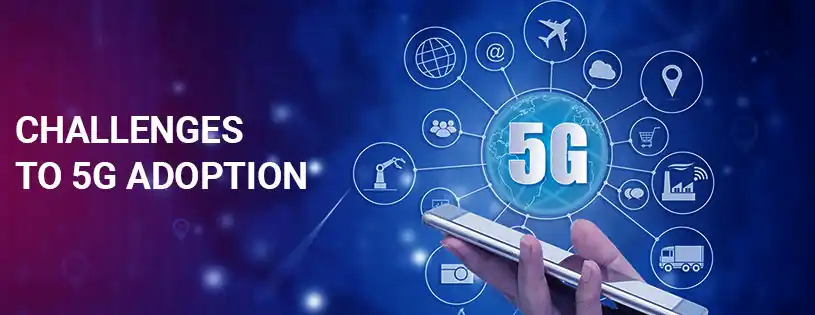Research
Share Knowledge
Brainstorm Ideas
Achieve More
With the growing spread of the 5th generation telecom network (5G), we seem to have ushered in a new era of speed, high availability, and connectivity. Massive network capacity, increased availability, coupled with ultra-low latency, promise multi-Gbps data speed with full reliability. But, speed unlocks only a part of the 5G potential that is capable of transforming industries, businesses, health, life, and living patterns of humans. The coming of 5G is an opportunity for enterprises to expand innovative solutions previously unimagined.
5G is not just an enhanced version of the 4G network. It’s a new kind of network. Going forward, the features of 5G will inform the way enhanced network-aware applications can be developed. The next-gen network is set to integrate mobile tech with Big Data, IoT, and cloud computing to generate myriad new applications.
Senior decision-makers including CTOs and CIOs must consider a paradigm shift toward innovation to unlock the full potential of 5G deployment. This calls for a comprehensive understanding of the performance requirements of each such application to facilitate the apt selection of the 5G technology feature. The real power of 5G lies in the ability of developers to interact, influence, and modify network-enabled applications into enhanced network-aware applications.
5G promises to drive innovations to unprecedented levels in so many new areas. Precision automation and robotics, telemedicine and telesurgery, augmented-reality workplace collaborations, immersive retail and entertainment experiences, autonomous vehicles, and smart factories powered by intelligent supply chains are only some significant solutions that this network enables.
Most CIOs and CTOs are hopeful that their organizations can leverage this advanced networking technology to create a significant competitive advantage. For starters, they believe the advanced connectivity will critically influence and enhance customer interactions in the near future.
That apart, organizations and enterprises are increasingly using these advanced wireless networks to connect employees, machines, and customers. Connectivity inside and outside offices is enhanced as workers are untethered from the desktop, phone, and wired connections with the required speed to carry voice and video. 5G is improving collaboration and productivity with high-resolution, multi-person video-conferencing, immersive collaboration experiences with virtual reality/augmented reality technologies.
In the manufacturing environment, 5G can provide high-bandwidth connectivity, especially in sites with limited wired possibilities and hostile conditions in challenging geographic locales. Banks and financial institutions can offer fully functional pop-up branches, or power real-time video chat consultations to discuss wealth management, college funding, or retirement finance with service experts.

5G is here to create a transformative impact on industries, and businesses with its trinitarian benefits – speed, lower latency, and the ability to host significantly more numbers of IoT connections simultaneously. But, the complexities that surround deployment and management of private 5G networks have posed to be a significant barrier in integrating legacy applications. Of course, some of those are challenges the telecom networks are actively working to overcome as launches go ahead but for the enterprise looking to adapt to a 5G world, the challenges are internal.
Enterprises just cannot provide ‘an apt use case’ overnight. The key to 5G's successful deployment is in leveraging insights from experts to help find disruptive use-cases suited for the enterprise and its operations. This calls for a strategic consulting effort to define and nail down the most creative and imaginative use of the 5G network in place of a standard strategy.
It is also unrealistic to expect application developers to gain a deep knowledge of the network architecture and the best way to monetize the network’s capabilities in an instant. There are many known and unknown challenges in refactoring older applications. The lack of knowledge in developing 5G-enabled next-gen applications is forcing CIOs to outsource development to managed service providers and system integrators.
Then there are the challenges with data, security, and access management. With advanced wireless poised to play a prominent role in remote management of employees’ mobile devices, IT professionals are pushing data-intensive updates to their device administration, and remote troubleshooting. Network stakeholders like CIOs and CISOs need to pay careful attention to the IT security challenges posed by high-bandwidth, low latency connects being enabled across enterprise endpoints.
In this complex and evolving ecosystem, enterprises may engage with multiple telecom and technology vendors to purchase best-of-breed components and seek help with integration. They will explore new relationships, security plans, and SLAs with application providers, wireless carriers, cloud companies, consulting firms, and integrators.
Another top concern of most adopters is the incompatibility of existing systems and devices. Enterprise CIOs need help to chart a path of smooth transition and integration. As CIOs and CTOs interweave business strategies with 5G, they need to base such decisions with deployment boundary conditions such as timelines, network technology availability, and security requirements
Not surprisingly, enterprises wanting to make informed decisions and action them will need access to a band of talented people with full expertise on the 5G landscape as well as a keen understanding of enterprise technology to tap its full benefits.
Evolving 5G networks are becoming available to drive significant growth of intelligent applications. Its lightning-fast connection, low-latency, and ability to serve a myriad of applications simultaneously are driving industry leaders, CIOs, and CTOs to create strategies that will leverage its benefits. Digital transformations efforts and innovation initiatives with fast connectivity at the core are more complex than can be imagined. The compatibility of existing systems and devices, adopting newer applications that are best suited for enterprise and business growth, nullifying security challenges, aligning with the best service providers with the apt infrastructure are formidable challenges that CIOs and CTOs have to overcome in the process of implementing best practices. Working with the right technology partner could become the most crucial first step on this exciting new journey.